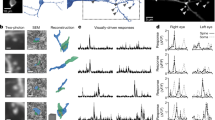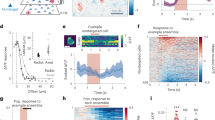Abstract
The receptive fields of neurons in primary visual cortex that are inactivated by retinal damage are known to 'shift' to nondamaged retinal locations, seemingly due to the plasticity of intracortical connections. We have observed in cats that these shifts occur in a pattern that is highly convergent, even among receptive fields that are separated by large distances before inactivation. Here we show, using a computational model of primary visual cortex, that the observed convergent shifts are inconsistent with the common assumption that the underlying intracortical connection plasticity is dependent on the temporal correlation of pre- and postsynaptic action potentials. The shifts are, however, consistent with the hypothesis that this plasticity is dependent on the temporal order of pre- and postsynaptic action potentials. This convergent reorganization seems to require increased neuronal gain, revealing a mechanism that networks may use to selectively facilitate the didactic transfer of neuronal response properties.
This is a preview of subscription content, access via your institution
Access options
Subscribe to this journal
Receive 12 print issues and online access
$209.00 per year
only $17.42 per issue
Buy this article
- Purchase on Springer Link
- Instant access to full article PDF
Prices may be subject to local taxes which are calculated during checkout






Similar content being viewed by others
Change history
11 July 2007
In the version of this article initially published, the author omitted an acknowledgement in the list of acknowledgements at the end of the article. The authors would like to acknowledge financial support contributed by the Berlin Graduate School of Mind and Brain, Germany.
Notes
*NOTE: In the version of this article initially published, the author omitted an acknowledgement in the list of acknowledgements at the end of the article. The authors would like to acknowledge financial support contributed by the Berlin Graduate School of Mind and Brain, Germany.
References
Hubel, D.H. & Wiesel, T.N. Binocular interaction in striate cortex of kittens reared with artificial squint. J. Neurophysiol. 28, 1041–1059 (1965)
Katz, L.C. & Shatz, C.J. Synaptic activity and the construction of cortical circuits. Science 274, 1133–1138 (1996).
Hebb, D.O. The Organization of Behaviour (John Wiley & Sons, New York, 1949).
Stent, G.S. A physiological mechanism for Hebb's postulate of learning. Proc. Natl. Acad. Sci. USA 70, 997–1001 (1973).
Malenka, R.C. & Nicoll, R.A. NMDA receptor–dependent synaptic plasticity: multiple forms and mechanisms. Trends Neurosci. 16, 521–527 (1993).
Levy, W.B. & Steward, O. Temporal contiguity requirements for long-term associative potentiation/depression in the hippocampus. Neuroscience 8, 791–797 (1983).
Markram, H., Lubke, J., Frotscher, M. & Sakmann, B. Regulation of synaptic efficacy by coincidence of postsynaptic APs and EPSPs. Science 275, 213–215 (1997).
Song, S., Miller, K.D. & Abbott, L.F. Competitive Hebbian learning through spike-timing–dependent synaptic plasticity. Nat. Neurosci. 3, 919–926 (2000).
Sjöström, P.J., Turrigiano, G.G. & Nelson, S.B. Rate, timing, and cooperativity jointly determine cortical synaptic plasticity. Neuron 32, 1149–1164 (2001).
Froemke, R.C. & Dan, Y. Spike-timing–dependent synaptic modification induced by natural spike trains. Nature 416, 433–438 (2002).
Dan, Y. & Poo, M.-M. Spike timing–dependent plasticity of neural pircuits. Neuron 44, 23–30 (2004).
Pearson, J.C., Finkel, L.H. & Edelman, G.M. Plasticity in the organization of adult cerebral cortical maps: a computer simulation based on neuronal group selection. J. Neurosci. 7, 4209–4223 (1987).
Obermayer, K., Ritter, H. & Schulten, K. A principle for the formation of the spatial structure of cortical feature maps. Proc. Natl. Acad. Sci. USA 87, 8345–8349 (1990).
Hirsch, J.A. & Gilbert, C.D. Long-term changes in synaptic strength along specific intrinsic pathways in the cat visual cortex. J. Physiol. (Lond.) 461, 247–262 (1993).
Xing, J. & Gerstein, G.L. Networks with lateral connectivity. 3. Plasticity and reorganization of somatosensory cortex. J. Neurophysiol. 75, 217–232 (1996).
Miikkulainen, R., Bednar, J.A., Choe, Y. & Sirosh, J. Self-organization, plasticity and low-level visual phenomena in a laterally connected map model of the primary visual cortex. in Psychology of Learning and Motivation: Perceptual Learning (eds. Goldstone, R.L., Schyns, P.G. & Medin, D.L.) 257–308 (Academic Press, San Diego, 1997).
Feldman, D.E. Timing-based LTP and LTD at vertical inputs to layer II/III pyramidal cells in rat barrel cortex. Neuron 27, 45–56 (2000).
Song, S. & Abbott, L.F. Cortical development and remapping through spike timing–dependent plasticity. Neuron 32, 339–350 (2001).
Fu, Y.X. et al. Temporal specificity in the cortical plasticity of visual space representation. Science 296, 1999–2003 (2002).
Eyding, D., Schweigart, G. & Eysel, U.T. Spatio-temporal plasticity of cortical receptive fields in response to repetitive visual stimulation in the adult cat. Neuroscience 112, 195–215 (2002).
Celikel, T., Szostak, V.A. & Feldman, D.E. Modulation of spike timing by sensory deprivation during induction of cortical map plasticity. Nat. Neurosci. 7, 534–541 (2004).
Meliza, C.D. & Dan, Y. Receptive-field modification in rat visual cortex induced by paired visual stimulation and single-cell spiking. Neuron 49, 183–189 (2006).
Pettigrew, J.D. The effect of visual experience on the development of stimulus specificity by kitten cortical neurones. J. Physiol. (Lond.) 237, 49–74 (1974).
Giannikopoulos, D.V. & Eysel, U.T. Dynamics and specificity of cortical map reorganization after retinal lesions. Proc. Natl. Acad. Sci. USA 103, 10805–10810 (2006).
Olson, C.R. & Freeman, R.D. Profile of the sensitive period for monocular deprivation in kittens. Exp. Brain Res. 39, 17–21 (1980).
Kaas, J.H. et al. Reorganization of retinotopic cortical maps in adult mammals after lesions of the retina. Science 248, 229–231 (1990).
Chino, Y. et al. Recovery of binocular responses by cortical neurons after early monocular lesions. Nat. Neurosci. 4, 689–690 (2001).
Waleszczyk, W.J. et al. Laminar differences in plasticity in cat area 17 following retinal lesions in adolescence or adulthood. Eur. J. Neurosci. 17, 2351–2368 (2003).
Fitzgibbon, T., Funke, K. & Eysel, U.T. Anatomical correlations between soma size, axon diameter and intraretinal length for the α ganglion cells of the cat retina. Vis. Neurosci. 6, 159–174 (1991).
Calford, M.B., Schmid, L.M. & Rosa, M.G.P. Monocular focal retinal lesions induce short-term topographic plasticity in adult cat visual cortex. Proc. Biol. Soc. 266, 499–507 (1999).
Calford, M.B. et al. Plasticity in adult cat visual cortex (area 17) following circumscribed monocular lesions of all retinal layers. J. Physiol. (Lond.) 524, 587–602 (2000).
Gilbert, C.D. & Wiesel, T.N. Receptive field dynamics in adult primary visual cortex. Nature 356, 150–152 (1992).
Darian-Smith, C. & Gilbert, C.D. Topographic reorganization in the striate cortex of the adult cat and monkey is cortically mediated. J. Neurosci. 15, 1631–1647 (1995).
Calford, M.B., Wright, L.L., Metha, A.B. & Taglianetti, V. Topographic plasticity in primary visual cortex is mediated by local corticocortical connections. J. Neurosci. 23, 6434–6442 (2003).
Young, J.M., Waleszczyk, W.J., Burke, W., Calford, M.B. & Dreher, B. Topographic reorganization in area 18 of adult cats following circumscribed monocular retinal lesions in adolescence. J. Physiol. (Lond.) 541, 601–612 (2002).
Tusa, R.J., Palmer, L.A. & Rosenquist, A.C. The retinotopic organization of area 17 (striate cortex) in the cat. J. Comp. Neurol. 177, 213–235 (1978).
Tanifuji, M., Sugiyama, T. & Murase, K. Horizontal propagation of excitation in rat visual cortical slices revealed by optical imaging. Science 266, 1057–1059 (1994).
Jancke, D., Chavane, F., Naaman, S. & Grinvald, A. Imaging cortical correlates of illusion in early visual cortex. Nature 428, 423–426 (2004).
Chino, Y.M., Kaas, J.H., Smith, E.L., III, Langston, A.L. & Cheng, H. Rapid reorganization of cortical maps in adult cats following restricted deafferentation in retina. Vision Res. 32, 789–796 (1992).
Turrigiano, G.G., Leslie, K.R., Desai, N.S., Rutherford, L.C. & Nelson, S.B. Activity-dependent scaling of quantal amplitude in neocortical neurons. Nature 391, 892–896 (1998).
Desai, N.S., Cudmore, R.H., Nelson, S.B. & Turrigiano, G.G. Critical periods for experience-dependent synaptic scaling in visual cortex. Nat. Neurosci. 5, 783–789 (2002).
Rutherford, L.C., Nelson, S.B. & Turrigiano, G.G. BDNF has opposite effects on the quantal amplitude of pyramidal neuron and interneuron excitatory synapses. Neuron 21, 521–530 (1998).
Arckens, L. et al. Cooperative changes in GABA, glutamate and activity levels: the missing link in cortical plasticity. Eur. J. Neurosci. 12, 4222–4232 (2000).
Darian-Smith, C. & Gilbert, C.D. Axonal sprouting accompanies functional reorganization in adult cat striate cortex. Nature 368, 737–740 (1994).
Trachtenberg, J.T. & Stryker, M.P. Rapid anatomical plasticity of horizontal connections in the developing visual cortex. J. Neurosci. 21, 3476–3482 (2001).
Anderson, J.S., Carandini, M. & Ferster, D. Orientation tuning of input conductance, excitation and inhibition in cat primary visual cortex. J. Neurophysiol. 84, 909–926 (2000).
Yoshimura, Y. & Callaway, E.M. Fine-scale specificity of cortical networks depends on inhibitory cell type and connectivity. Nat. Neurosci. 8, 1552–1559 (2005).
Bringuier, V., Chavane, F., Glaeser, L. & Frégnac, Y. Horizontal propagation of visual activity in the synaptic integration field of area 17 neurons. Science 283, 695–699 (1999).
Hirsch, J.A. & Gilbert, C.D. Synaptic physiology of horizontal connections in the cat's visual cortex. J. Neurosci. 11, 1800–1809 (1991).
Colman, H., Nabekura, J. & Lichtman, J.W. Alterations in synaptic strength preceding axon withdrawal. Science 275, 356–361 (1997).
Acknowledgements
We thank W. Burke for participating in the experimental work; J.Y. Huang for participating in the control experiments; T. Hoch for modeling advice; and K. Wimmer, E. Mukamel, L. Schwabe, T. Hoch and R. Martin for manuscript comments. Support was contributed by the Australian Research Council, the Bernstein Center for Computational Neuroscience Berlin, the German Federal Ministry of Education and Research (BMBF, grant 10025304), and the German Academic Exchange Service (DAAD).*Footnote 1
Author information
Authors and Affiliations
Contributions
J.M.Y., W.J.W., C.W. and B.D. conducted the experimental work and analyzed the collected data. M.B.C. made the retinal lesions. B.D. and M.B.C. designed the experiments. K.O. supervised the modeling project, which included providing guidance on the choice of model type and advice on the model's abstractions. J.M.Y. conceived the modeling project and conducted the modeling work, which included developing the model's novel abstractions. The manuscript was drafted primarily by J.M.Y., but all the authors were actively involved in its refinement.
Corresponding authors
Ethics declarations
Competing interests
The authors declare no competing financial interests.
Supplementary information
Supplementary Fig. 1
Comparison of hand-plotting and automated estimates of receptive field location. (PDF 22 kb)
Supplementary Fig. 2
The correspondence between hand-plotted and automated estimates of receptive field location relative to the distance of estimated receptive field shifts. (PDF 14 kb)
Supplementary Fig. 3
Receptive field position shifts and orientation preference among in vivo neurons within the lesion projection zone. (PDF 22 kb)
Supplementary Fig. 4
Influence of neuronal gain on receptive field reorganization in simulations using spike timing-dependent plasticity. (PDF 128 kb)
Supplementary Video 1
KR1 (AVI 1040 kb)
Supplementary Video 2
KR2 (AVI 939 kb)
Supplementary Video 3
KR4 (AVI 1425 kb)
Supplementary Video 4
KR5 (AVI 914 kb)
Supplementary Video 5
KL12 (AVI 1486 kb)
Rights and permissions
About this article
Cite this article
Young, J., Waleszczyk, W., Wang, C. et al. Cortical reorganization consistent with spike timing–but not correlation-dependent plasticity. Nat Neurosci 10, 887–895 (2007). https://doi.org/10.1038/nn1913
Received:
Accepted:
Published:
Issue Date:
DOI: https://doi.org/10.1038/nn1913
This article is cited by
-
Spike Timing-Dependent Plasticity in the Mouse Barrel Cortex Is Strongly Modulated by Sensory Learning and Depends on Activity of Matrix Metalloproteinase 9
Molecular Neurobiology (2017)
-
Using theoretical models to analyse neural development
Nature Reviews Neuroscience (2011)
-
Capacity of networks to develop multiple attractors through STDP
BMC Neuroscience (2009)
-
Thalamic activity that drives visual cortical plasticity
Nature Neuroscience (2009)
-
Traveling waves in developing cerebellar cortex mediated by asymmetrical Purkinje cell connectivity
Nature Neuroscience (2009)



